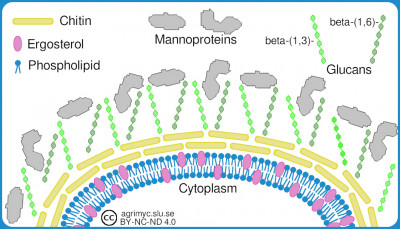| Show all terms |
Cellvägg och cellmembranA schematic image of the fungal cell envelope. It is mainly dermatophytes that have mannoproteins. - Click on the image to enlarge it.
IntroductionThe cell wall and the cell membrane are very important structures of fungi because they form the fungal contact surface with the environment. For bacteria, the cell wall and the cell membrane together are usually called the cell envelopes. The same terminology is here used for fungi. Fungi, like other living organisms, have a cell membrane, which consists of a double lipid layer. In fungi, these lipids consist mainly of phospholipids and sphingolipids. The cell membrane of the fungi is thus similar to the cell membrane of mammals, but unlike these, fungi have ergosterol instead of cholesterol in their cell membrane. Many antifungal substances act by inhibiting the synthesis of ergosterol. Like other organisms, the fungi also have proteins in their cell membrane, whichare responsible for transport and biosynthesis etc. However, these are not drawn in the figure. The cell wall consists of a chitin layer, and a layer of glucans (d-glucose polymers). Dermatophytes also have so-called mannoproteins (a type of glycoprotein) on the outside of the cell wall. Updated: 2021-10-14. |

